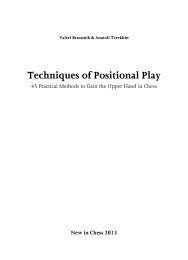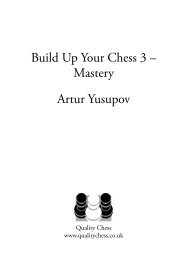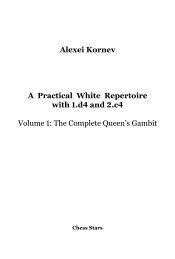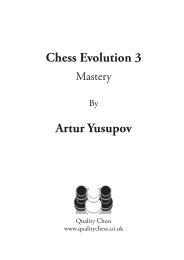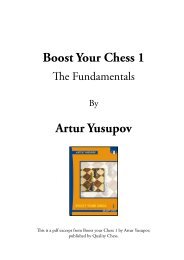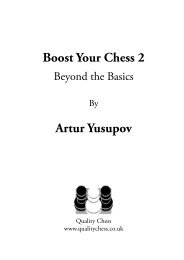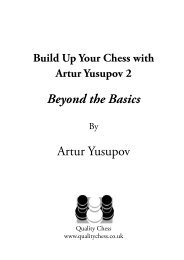Playing the Trompowsky Richard Pert - Quality Chess
Playing the Trompowsky Richard Pert - Quality Chess
Playing the Trompowsky Richard Pert - Quality Chess
- No tags were found...
You also want an ePaper? Increase the reach of your titles
YUMPU automatically turns print PDFs into web optimized ePapers that Google loves.
<strong>Playing</strong> <strong>the</strong> <strong>Trompowsky</strong>By<strong>Richard</strong> <strong>Pert</strong><strong>Quality</strong> <strong>Chess</strong>www.qualitychess.co.uk
ContentsKey to Symbols used & Bibliography 4Preface 5Introduction 71 2...e6 3.e4 112 2...e6 3.¤d2!? 473 2...c5 3.¤c3!? 614 2...c5 3.d5 795 2...¤e4 3.¥f4 c5 4.d5 936 2...¤e4 3.¥f4 c5 4.f3 1077 2...d5 3.¥xf6 1418 2...d5 3.e3 1579 2...¤e4 3.¥f4 d5 4.e3 17110 Rare 3rd Moves 19311 Rare 2nd Moves 20112 2.¥g5 against <strong>the</strong> Dutch 21113 1.d4 d5 2.¥g5 233Variation Index 263
8 <strong>Richard</strong> <strong>Pert</strong> – <strong>Playing</strong> <strong>the</strong> <strong>Trompowsky</strong><strong>Trompowsky</strong>. For example, in <strong>the</strong> main line which continues 1.d4 ¤f6 2.¥g5 ¤e4 3.¥f4 c5, I haveactually given <strong>the</strong> reader three choices – sacrificing two pawns for a massive attack, sacrificing onepawn for some initiative, or sacrificing no pawns but instead looking to obtain a small but solidedge. Often I think it is useful to have a second choice in your back pocket for surprise value.I haven’t offered as much choice against 1...f5 and 1...d5, focusing more on providing one goodrepertoire. I’m particularly pleased with my work against <strong>the</strong> Dutch and it looks to me that after1.d4 f5 2.¥g5 Black is struggling to hold <strong>the</strong> balance. I’ve also given a repertoire against 1...d5, andwhilst I think that White may not be able to prove an advantage here against accurate play fromBlack, <strong>the</strong> positions look interesting and fully playable.Book StructurePersonally I read a lot of chess books on <strong>the</strong> train, as I have commuted on virtually a daily basis over<strong>the</strong> past ten years. As a result I have a good knowledge of <strong>the</strong> books I find easy to read, and <strong>the</strong> onesI struggle to find my way around.I have tried in this book to lay everything out as logically as possible. I have taken time at <strong>the</strong>start of each chapter to give an overview of Black’s possibilities, showing clearly all his options andhighlighting any transpositions, and also showing where a second option is offered for White. Onefur<strong>the</strong>r thing I’ve done is to make it clear which move I think should be played in each position.I have seen several previous authors take <strong>the</strong> approach of putting a collection of model gamestoge<strong>the</strong>r, but have <strong>the</strong>n found that I ended up not knowing what <strong>the</strong> right move was in eachposition.To help you find your way around <strong>the</strong> material, let me tell you some more about <strong>the</strong> chapters.Chapter 1: 1.d4 ¤f6 2.¥g5 e6 3.e42...e6 is one of Black’s most solid choices and has risen in popularity in recent years to <strong>the</strong> pointthat it is now Black’s second most popular response to <strong>the</strong> <strong>Trompowsky</strong>. Black’s idea is to preventhis pawns being doubled by taking <strong>the</strong> time to protect <strong>the</strong> f6-knight with his queen. That said, <strong>the</strong>move is slightly passive and gives us <strong>the</strong> chance to grab <strong>the</strong> initiative.Here I have given two choices for White. The main move which I focus on in this chapter is3.e4, grabbing space in <strong>the</strong> middle of <strong>the</strong> board. My idea is to follow 3...h6 4.¥xf6 £xf6 with <strong>the</strong>modern 5.c3, where I have extensive personal experience. Although Black is quite solid, I believethat White has good chances of an advantage.The chapter also features new ideas against 3...c5, where I have a very powerful idea in <strong>the</strong> mainline.Chapter 2: 1.d4 ¤f6 2.¥g5 e6 3.¤d2The second option against 2...e6 that I cover is <strong>the</strong> flexible 3.¤d2!?. This approach has becomepopular amongst <strong>the</strong> world’s elite in recent years, particularly in blitz and rapid games.Chapter 3: 1.d4 ¤f6 2.¥g5 c5 3.¤c3With 2...c5 Black indicates he is ready to do battle! This uncompromising move was suggested byDembo in her highly-rated book, Fighting <strong>the</strong> Anti-King’s Indians, which came out in 2008.In this chapter I take a look at a repertoire involving <strong>the</strong> quirky 3.¤c3!? which I have played on a
130 <strong>Richard</strong> <strong>Pert</strong> – <strong>Playing</strong> <strong>the</strong> <strong>Trompowsky</strong>of <strong>the</strong> resulting positions makes <strong>the</strong>m quitehard to accurately evaluate, on <strong>the</strong> whole <strong>the</strong>positions do seem to favour White. Certainlyfrom a practical viewpoint I would considerWhite favourite, especially if he is familiarwith <strong>the</strong> following extensive analysis.Black’s main choices are now B321) 9...b6?!,B322) 9...e6 and B323) 9...d6.9...g6?! was played in <strong>the</strong> first game in thisline, but it doesn’t seem to work and it hasrarely been tried since: 10.¦c1 £e3† 11.¤e2¤a6 12.¤c4 £h6 13.¥f4 £g7 14.£a4 g515.¥e5 g4 16.f4 £g6 17.¤g3± Chernyshov– Grischuk, Dagomys 2005; Black is totallypassive and White’s advantage is significant.B321) 9...b6?!Black seems to be struggling in this line.10.¦c1!This move is White’s best; <strong>the</strong> reason isthat if Black retreats with ...£a5, he cannotsubsequently play ...b5 as <strong>the</strong> c5-pawn woulddrop to ¦xc5.10.¤e2I played this move in a London Leaguegame against Bob Eames, who kindly toldme after <strong>the</strong> game that 10.¦c1 is White’sbest. The reason I say “kindly told me” isbecause <strong>the</strong> next year he advised his goodfriend Dave Ledger to try this line againstme in Hastings, and I got a chance to try out<strong>the</strong> improvement – I am not quite sure whatBob’s logic was <strong>the</strong>re, but thanks anyway!Despite <strong>the</strong> substandard knight move <strong>the</strong>position remains interesting, so I haveincluded <strong>the</strong> game.10...£a510...£a3 11.¦b1 ¥a6! 12.¦b3 £a5 13.£c1÷11.¥e5 11...b511...d6 12.¥c3 £a3 13.¤c4 £a6 14.¤g3÷12.a4 b4 13.¤c4 £d8 14.d6 e614...¤c6 15.dxe7 ¥xe7 16.¤d6†÷15.¤f4 ¤c6 16.¥b2With e4-e5 on <strong>the</strong> cards.16...g5 17.¤d3 ¥g7 18.¤xc5 0–0 19.£d2¤h5 20.e5 20...¤f4?This allows White to break open <strong>the</strong> h-file.20...f6! 21.¥d3²21.h4 f6 22.hxg5 fxg522...fxe5 23.¥d3²23.¥d3 ¤xd3† 24.£xd3 h6 25.£g6 ¦f4?25...£e8 26.¦xh6 £xg6 27.¦xg6 ¦f4(27...¦f5 28.¤e3±) 28.¦c1 ¢f7 29.¦xg5±26.¦xh6 ¤d4?26...¦h4 27.£h7†+–27.¥xd4 ¦xd4 28.£h7† ¢f8 29.¦g6!1–0 R. <strong>Pert</strong> – Eames, London 2009.
132 <strong>Richard</strong> <strong>Pert</strong> – <strong>Playing</strong> <strong>the</strong> <strong>Trompowsky</strong>– I couldn’t believe my eyes that playing myknight into <strong>the</strong> corner could be such a strongmove.17...e617...¦xb8 18.¤c7† ¢d8 19.£a5+–18.¤c7† ¢d8 19.¤xa6 exd5 20.e5 dxe521.£a5† ¢c8 22.¥xe5 ¦a7 23.¤f4 £g524.£c3 ¥c6 25.¤b4 d4 26.¥xd4 £xf427.¤xc6 ¦xa2 28.¥e5 £a4 29.¤b4 ¦a330.¥a6† ¢d7 31.£d2† ¢e6 32.¥c8† ¢xe533.f4† ¢e4 34.¦c4#R. <strong>Pert</strong> – D. Ledger, Hastings 2010.B322) 9...e6 + o I consider this as an important option forBlack and one we should be ready for. Thereare very few games in this line so much of <strong>the</strong>analysis below has not been tested in practice,but I have spent a lot of time on this variationto ensure that <strong>the</strong> analysis can be trusted.10.¤e2 £d3Swinging <strong>the</strong> queen over to <strong>the</strong> kingside with10...£e3?! seems wrong when <strong>the</strong> white bishopcan come back to <strong>the</strong> f4-square: 11.¤c4 £h612.¥f4 g5 13.¤d6† ¥xd6 14.¥xd6²10...£a3 11.¦b1!NThis move is far stronger than 11.¦c1?because <strong>the</strong> rook is going to <strong>the</strong> 3rd rankand on <strong>the</strong> c3-square it can be attacked by...¤xd5, whereas that is not <strong>the</strong> case on <strong>the</strong>b3-square: 11...exd5 12.¦c3 £a6 13.¦e3(13.exd5 ¤xd5–+) 13...¥e7µ Walton –G. Buckley, Coventry 2007.11...exd5?!Black should probably prefer 11...c4 12.dxe6and:a) 12...fxe6 13.¤xc4 £c5 14.¤d6†²b) 12...£c5 13.exf7† ¢xf7 14.¥f4 c3?15.¤xc3 £xc3 16.¦c1 £d4 17.¦xc8+–c) 12...dxe6 13.¤xc4 ¥b4† 14.¢f2 ¥c5†15.¤d4 £c3 16.¤d6† ¢e7 17.¤6b5¥xd4† 18.£xd4 £xd4† 19.¤xd4 ¤bd720.¥e2²12.¦b3 £a6 13.exd5!With <strong>the</strong> white rook on b3 instead of c3,
Chapter 6 – 2...¤e4 3.¥f4 c5 4.f3133this is not just possible but very strong –perhaps even winning.13...¤xd5Virtually forced as ¤c3 threatens to win <strong>the</strong>queen.14.¤f4 £c6 15.¥b5 £xc7 16.¤xd5 £d617.¤c4+–White will quickly develop his rooks to <strong>the</strong>e-file and mate looks likely.11.¦b1!As against 10...£a3, White threatens ¦b3which would be close to winning.11...c4!It may not be obvious to <strong>the</strong> unpreparedplayer, but this move is close to being forced.11...exd5 12.¦b3 £a6 13.exd5! transposes to<strong>the</strong> note to Black’s 10th move above. 12.¥f4!This move looks totally bizarre and I hadbeen aware of this position for some monthsbefore I realized it may well be <strong>the</strong> way to go.The idea is to follow up with ¦c1 and ei<strong>the</strong>r¦c3 or ¤c3, while ¤g3 is also on <strong>the</strong> cards.White’s plan seems slow, but it is effective andit puts <strong>the</strong> onus on Black to come up withsomething.12.¥e5!?This was <strong>the</strong> first idea I looked at, preparing¤c3.12...exd512...¥c5 13.¤xc4 £xd1† (13...£xc414.¤c3±) 14.¦xd1 and White hascompensation for <strong>the</strong> pawn.13.¤c3 £e3† 14.£e2 £xe2† 15.¥xe2 dxe4At this exact moment White may be fourpawns down, but <strong>the</strong> compensation isobvious. 16.¤b5!?16.¥xf6!? exf3 (16...gxf6 17.¤dxe4 f518.¤f6† ¢d8 19.¥xc4©) 17.¥xf3 gxf618.¤b5 (18.¤xc4 ¤c6 19.¤b5 ¢d820.¤bd6©) 18...¤a6 19.¤xc4©16...¤a616...exf3 17.¤c7† ¢d8 18.¤xf3 ¤c619.¤xa8 ¥c5 20.¥c7† ¢e7 21.¥xc4 d522.¥e2²16...¤c6 17.¥xf6 gxf6 18.¤c7† ¢d819.¤xa8²17.¤xc4 d5 18.¤cd6† ¥xd6 19.¤xd6† ¢e720.¤xb7÷Although White has compensation inall <strong>the</strong>se lines, it is not clear that he has anyadvantage.12...exd5I have looked at various o<strong>the</strong>r possibilities:12...c3? 13.¤xc3 £xc3 14.¦c1+–
134 <strong>Richard</strong> <strong>Pert</strong> – <strong>Playing</strong> <strong>the</strong> <strong>Trompowsky</strong>12...¥c5?! 13.¦c1² and White threatens ¦c3.12...¥a3?! 13.¤g3 £c3 14.¥xc4²12...¤h5?! 13.¤g3 ¤xf4 14.¥xd3 cxd315.¤c4 ¤xg2† 16.¢f1²12...¤a6 13.¦c1 ¤h5 (13...¥b4 14.¤c3£d4 15.¤b5 £b6 16.¦xc4 0–0 17.¦xb4¤xb4 18.¤c7 ¤h5? 19.¤c4+–) 14.¤c3 (or14.¤g3!?) 14...£d4 (14...¤xf4 15.¥xd3²)15.¤b5 £c5 (15...£b6 16.¤xc4±) 16.¦xc4£b6 17.¥e5²13.¦c1 13...£a3Black gets his queen out of <strong>the</strong>re before ¦c3or ¤c3 lands.13...dxe4? 14.¦xc4 ¤c6 15.¤c3 ¤e5 16.¥xd3¤xd3† 17.¢f1+–13...¤h5 14.¤c3 ¤xf4 15.¥xd3 ¤xd3†16.¢f1 ¤a6 17.¦b1²13...¥b4Black looks for quick development.14.¤c3 £d4Black can give up his queen with 14...£xc3but White should be better, although <strong>the</strong>position remains somewhat murky: 15.¦xc3¥xc3 16.£c1 ¥xd2† 17.£xd2 0–0 18.¥e5d6 19.¥xf6 gxf6 20.£f4²15.¤b5 £c515...£b6 16.¤c7† ¢f8 17.¤xa8+– picks up<strong>the</strong> a8-rook with tempo.16.¤d6† ¢f816...¢e7 17.¥xc4² 17.a3White can also consider 17.¥xc4!? with <strong>the</strong>idea: 17...dxc4? 18.¦xc4+–17...¥xd2†17...¥xa3 18.¤6xc4²18.£xd2 ¤c6 19.¤f5 ¤e8 20.£xd5 £xd521.exd5²14.¤c3 W N 14...¥b4
Chapter 6 – 2...¤e4 3.¥f4 c5 4.f3135White keeps an edge against all <strong>the</strong>alternatives:14...¤a6 15.exd5 ¥b4 16.¤b5 £a5 17.¥xc4²14...¤h5 15.¥e3²14...£a5 15.exd5 ¥b4 16.£e2† ¢d817.£xc4²15.¤b5 £a5 16.¤c7† ¢f816...¢e7 17.exd5 c3 18.£e2† ¢d8 19.¤b3c2† 20.¢f2 £b6† 21.£e3 £xe3† 22.¢xe3 d623.¦xc2² 17.¥xc4!?NAn interesting winning attempt.It was only after carrying out <strong>the</strong> above analysisthat I discovered that <strong>the</strong>re had been an emailgame which followed this route:17.¤xa8!? c3 18.¢f218.¦c2÷18...¥c5† 19.¢e219.¢e1 ¥b4! is a repetition of moves.19...cxd2 20.£xd2 £xd2† 21.¢xd2 ¥b4†22.¢d3 dxe4† 23.fxe4 ¤c6 24.¤c7 ¥a325.¦c3 ¥b4 26.¦c1 ¥a3 27.¦c3½–½ Klausen – Serradimigni, email 2007.17...dxc4 18.¤xa8 ¤c618...c3 19.0–0 ¥c5† 20.¢h1 cxd2 21.¥xd2£a3 22.¦xc5 £xc5 23.¥f4 d5 24.¥xb8 ¥d725.¤c7 d4 26.£d2²19.¦xc4 d5 20.¦c2 dxe4 21.0–0 exf322.¤xf3With two pawns for <strong>the</strong> exchange, materialis roughly level, but <strong>the</strong> misplaced black kingoffers some encouragement to White.B323) 9...d6 10.¦b1!I believe this is strongest.10.¤e2!?This move works well against ...£e3, but <strong>the</strong>problem is that it gives Black an additionaloption:10...£d3!Black should take this option although <strong>the</strong>position remains murky.10...£e3 11.¦b1 transposes into a veryfavourable line for White – see 10...£e3† in<strong>the</strong> following note.11.¦b111.¦c1 ¤bd7 12.¦c3 £a6 13.¤d4!? cxd414.¥xa6 dxc3 gives Black enough materialfor <strong>the</strong> queen.11.¤g3 £e3† 12.¥e2 ¤a6³11...b6



